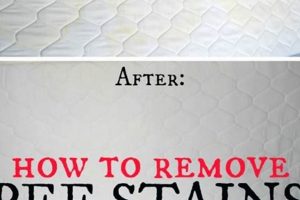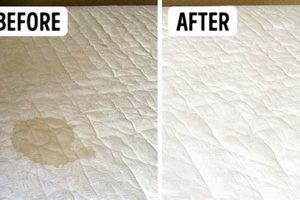The process of disposing of a used bed can present logistical and financial challenges. Many individuals seek methods that do not involve incurring additional expenses. The central issue is finding cost-effective or no-cost alternatives to traditional disposal methods, such as landfill disposal, which often carries a fee. Example strategies include donation, recycling programs, and municipal waste disposal options.
Proper disposal of a bed offers several advantages. It prevents environmental damage associated with improper landfilling, contributes to resource recovery through recycling initiatives, and supports community assistance programs via donation channels. Historically, bed disposal involved simply discarding them at landfills. However, growing environmental awareness and increased material recovery efforts have led to more sustainable practices.
The subsequent sections will detail various pathways to accomplish this objective, encompassing options such as leveraging community resources, participating in recycling initiatives, exploring donation possibilities, and understanding local waste management protocols. These approaches will provide a comprehensive overview of viable strategies.
Strategies for Disposing of a Used Bed Without Cost
The subsequent guidelines offer practical methods for responsibly removing a used bed without incurring expenses. These suggestions encompass various community resources and environmentally conscious approaches.
Tip 1: Consult Local Waste Management Services: Inquire with the local municipality regarding bulk waste collection days or designated drop-off locations for large items. Certain areas provide free or low-cost disposal programs for residents.
Tip 2: Explore Recycling Programs: Investigate local recycling facilities or organizations that specialize in bed component recycling. Many facilities accept beds and dismantle them to recover materials such as steel, foam, and fabric.
Tip 3: Investigate Charitable Donation Options: Contact local charities or non-profit organizations to determine if they accept used beds. Ensure the bed meets the organization’s condition standards and sanitation requirements.
Tip 4: Utilize Online Community Platforms: Employ online platforms such as community bulletin boards or local social media groups to advertise the bed for free pickup. Clearly state the condition and removal requirements.
Tip 5: Deconstruct the Bed for Alternative Uses: Consider disassembling the bed and repurposing its components. The wood frame can be used for construction projects, while the foam and fabric can be used for padding or crafting purposes.
Tip 6: Contact Local Retailers: Some retailers offer bed removal services when a new bed is purchased. Inquire whether the retailer provides complimentary or discounted removal of the old bed.
Tip 7: Community Clean-Up Events: Participate in community clean-up initiatives, which often include the collection of large or bulky items. This offers an opportunity to responsibly dispose of the bed alongside other discarded materials.
Employing these strategies contributes to responsible waste management practices by diverting materials from landfills and promoting resource recovery. Furthermore, it facilitates community support through charitable donations.
The following section will provide guidance on navigating potential challenges and considerations associated with bed disposal. This information will ensure informed decision-making in the disposal process.
1. Donation availability.
The capacity to donate a used bed significantly influences the ability to achieve bed removal at no cost. Donation, when feasible, presents a viable alternative to landfill disposal or paid removal services. Its suitability, however, hinges on several pre-existing conditions.
- Mattress Condition Requirements
Charitable organizations typically impose stringent condition standards for accepting bed donations. Beds must be free from stains, tears, infestations (e.g., bed bugs), and structural damage. These stipulations ensure the bed is sanitary and suitable for recipient use. A bed failing to meet these standards is unlikely to be accepted, thereby negating the donation option.
- Charity Acceptance Policies
Not all charities accept bed donations. Organizations may have specific needs, storage limitations, or restrictions based on prior negative experiences with bed bug infestations. Researching local charities and confirming their acceptance policies before attempting donation is critical. Organizations like homeless shelters or furniture banks are potential recipients, but confirmation is essential.
- Transportation Logistics
Even if a charity accepts bed donations, individuals may be responsible for transporting the bed to the donation site. This can present logistical challenges, especially for those lacking a suitable vehicle or the physical capacity to move a heavy item. Transportation costs or difficulties could render the donation option impractical.
- Tax Deduction Opportunities
Donating a bed to a qualifying charity may provide a tax deduction opportunity. However, the value of the deduction is contingent on the bed’s fair market value and the individual’s tax situation. While not a direct cost-saving measure, a tax deduction can offset some of the financial burden associated with acquiring a new bed after the old one is donated.
The availability of donation opportunities is a pivotal factor in attaining cost-free bed removal. However, its viability is subject to mattress condition, charity acceptance policies, transportation logistics, and potential tax benefits. Successfully navigating these elements is essential for utilizing donation as a method to responsibly discard a used bed without incurring expenses.
2. Recycling accessibility.
Recycling accessibility directly influences the feasibility of discarding a used bed without incurring costs. When recycling facilities or programs are readily available, the financial burden of disposal shifts from the individual to the recycling infrastructure. This accessibility hinges on geographic location, municipal support for recycling initiatives, and the operational capacity of local recycling centers. For instance, certain cities offer curbside collection of bulky items for recycling, effectively eliminating disposal fees for residents. Conversely, in areas lacking such infrastructure, individuals face potential transport costs and landfill charges, thereby increasing the overall expense.
The importance of accessible recycling programs stems from the material composition of beds. Steel springs, foam padding, and fabric covers can be reclaimed and reused, reducing the demand for virgin resources. Numerous examples demonstrate the practical application of recycling. Bye Bye Mattress, a program operating in several states, facilitates the collection and recycling of beds through a network of drop-off sites and collection events. Similarly, some private companies specialize in bed dismantling, recovering valuable materials and diverting waste from landfills. The presence and promotion of such initiatives contribute significantly to reducing disposal costs for the public.
In conclusion, recycling accessibility serves as a critical determinant in achieving cost-free bed disposal. Its presence allows individuals to leverage existing infrastructure for responsible waste management. However, variations in program availability and operational capacity necessitate that individuals investigate local options to ascertain if recycling offers a practical and financially advantageous disposal method. The expansion of these programs holds the potential to further reduce the cost and environmental impact associated with discarding used beds.
3. Municipal programs.
Municipal programs often represent a cornerstone in providing accessible, cost-free solutions for bed disposal. These programs, funded through local government initiatives or waste management fees, directly address the logistical and financial challenges associated with removing bulky items like beds. Their significance lies in their capacity to provide residents with pre-determined collection schedules, designated drop-off locations, or subsidized recycling opportunities, effectively circumventing the need for private disposal services and their associated costs. The efficacy of municipal programs is contingent on their implementation and promotion to residents.
Examples of such programs include scheduled bulk waste collection events, where residents can place large items curbside for municipal collection, or the provision of free drop-off days at local landfills or transfer stations. Some municipalities even partner with recycling centers to offer discounted or free bed recycling services to residents, diverting reusable materials from landfills. The practical application involves residents contacting their local waste management department to ascertain the availability of these programs, understanding the specific guidelines for participation, and adhering to collection schedules or drop-off procedures. Failure to follow municipal guidelines may result in rejection of the items and the need for alternative disposal methods.
In conclusion, municipal programs are pivotal in realizing cost-free bed disposal for residents. By offering structured collection events, accessible drop-off locations, and subsidized recycling services, these programs alleviate both the financial and logistical burdens associated with discarding large items. However, the success of these initiatives hinges on resident awareness and adherence to established guidelines, as well as consistent municipal funding and efficient program management. Their sustained operation contributes significantly to responsible waste management within the community.
4. Component repurposing.
Component repurposing presents a viable pathway toward achieving bed disposal at no cost. This strategy involves disassembling the bed and utilizing its constituent materials for alternative purposes, thus averting landfill fees and potentially generating savings.
- Steel Spring Reclamation
Steel springs, a primary component of many beds, possess intrinsic value as recyclable material. These springs can be disassembled and delivered to metal recycling facilities. Depending on market conditions and the quantity of material, this process may yield a nominal financial return, offsetting potential disposal costs. Furthermore, the steel can be repurposed in various manufacturing processes, contributing to resource conservation.
- Foam Padding Applications
Foam padding, commonly found in beds, can be repurposed for numerous applications. Smaller pieces can be used as packing material for fragile items, reducing the need to purchase new packing supplies. Larger sections of foam can be utilized as cushioning for furniture projects or as padding in pet beds. These applications minimize waste and diminish the demand for newly manufactured foam products.
- Wood Frame Utilization
The wooden frame of a bed offers significant repurposing potential. The wood can be disassembled and used for small-scale construction projects, such as building shelves, garden boxes, or other functional items. Alternatively, the wood can be repurposed as firewood, providing a heating source and minimizing wood waste. The value derived from the wood frame depends on its quality and the user’s skills in woodworking or construction.
- Fabric Cover Repurposing
Fabric covers from beds, if in reasonable condition, can be repurposed for various sewing or crafting projects. The fabric can be used to create patches for clothing, linings for bags, or material for small upholstery projects. If the fabric is no longer suitable for use, it can still be used as cleaning rags, further extending its utility and reducing the need for disposable cleaning products.
The effective repurposing of bed components directly contributes to cost-free disposal by minimizing waste and maximizing the utility of existing materials. While the financial benefits may vary depending on material type, quantity, and local market conditions, the reduction in disposal fees and the potential for resource conservation render component repurposing a valuable strategy for responsible waste management.
5. Community resources.
Community resources represent a crucial facet in the landscape of cost-free bed disposal. The accessibility and utilization of these resources can significantly mitigate the financial burden typically associated with removing a used bed, offering alternatives to traditional waste disposal methods.
- Local Charities and Non-Profit Organizations
Charitable organizations frequently accept donations of used beds, providing a service to individuals seeking disposal options while simultaneously aiding those in need of furniture. This symbiotic relationship hinges on the condition of the bed, as charities generally require items to be clean, free of damage, and devoid of infestations. For example, furniture banks and homeless shelters often accept beds that meet their specific standards, enabling both the donor and recipient to benefit.
- Municipal Waste Management Services
Municipal waste management departments often offer programs or services designed to assist residents with the disposal of bulky waste items, including beds. These services may include scheduled bulk waste collection days, drop-off locations for large items, or subsidized recycling programs. Residents can contact their local waste management department to inquire about available options and associated guidelines, potentially avoiding disposal fees and transportation costs.
- Online Community Platforms
Online platforms, such as community bulletin boards, social media groups, and freecycle websites, serve as valuable resources for connecting individuals with those who may be interested in acquiring a used bed. By posting a listing on these platforms, individuals can offer their bed for free pickup, avoiding disposal fees and potentially finding a new home for the item. The success of this approach depends on the condition of the bed and the willingness of others to remove it.
- Local Recycling Centers and Programs
Certain communities offer specialized recycling programs for beds, recognizing the value of the materials they contain. These programs often involve dismantling the bed and recovering components such as steel springs, foam padding, and fabric covers for reuse. By participating in these recycling programs, individuals can divert waste from landfills and potentially avoid disposal fees, contributing to environmental sustainability.
The strategic utilization of community resources provides a multi-faceted approach to achieving cost-free bed disposal. By leveraging local charities, municipal services, online platforms, and recycling programs, individuals can effectively minimize disposal expenses while contributing to community support and environmental responsibility. These resources underscore the importance of community engagement in sustainable waste management practices.
Frequently Asked Questions
The following addresses common inquiries regarding strategies for the disposal of used beds without incurring expenses. It clarifies relevant considerations and provides guidance.
Question 1: What are the primary options for disposing of a bed without incurring costs?
Primary options include leveraging municipal waste management services, exploring bed recycling programs, donating to charitable organizations, utilizing online community platforms for free pickup, and deconstructing the bed for alternative component uses.
Question 2: What conditions must a bed meet to be eligible for donation?
Generally, beds must be clean, free from stains, tears, infestations (e.g., bed bugs), and structural damage. Specific requirements vary by charitable organization, therefore direct inquiry is crucial prior to transportation.
Question 3: How can local recycling programs be identified?
Contacting local waste management services, consulting municipal websites, or searching online for bed recycling facilities in the area are effective methods. Programs such as Bye Bye Mattress operate in select states.
Question 4: What types of components can be salvaged from a bed for repurposing?
Components such as steel springs, foam padding, wood frames, and fabric covers can be repurposed for various applications, ranging from metal recycling to crafting projects and construction.
Question 5: What if municipal waste services do not offer free bulky item pickup?
Alternative strategies involve exploring options such as online community platforms, where the bed can be advertised for free pickup, or contacting local retailers to inquire about bed removal services when purchasing a new bed.
Question 6: Are there any potential drawbacks to relying on free disposal methods?
Potential drawbacks include the time and effort required to locate and coordinate with suitable disposal options, as well as the possibility that the bed may not meet the acceptance criteria of certain organizations or programs. Flexibility and persistence are often required.
Successful implementation of strategies for no-cost bed disposal relies on diligent research, adherence to specific program guidelines, and a realistic assessment of the bed’s condition.
The subsequent section addresses challenges and considerations related to bed disposal, thereby providing a framework for informed decision-making in the disposal process.
Conclusion
The preceding exploration outlines various pathways to how to get rid of old mattress for free. The feasibility of each hinges on factors like mattress condition, community resources, and local regulations. Strategies encompass donation, recycling, municipal programs, component repurposing, and community platforms.
Selecting an appropriate disposal method contributes to responsible waste management and resource conservation. Therefore, diligent research and adherence to local guidelines are paramount to ensure both cost-effectiveness and environmental stewardship when discarding a used bed.







